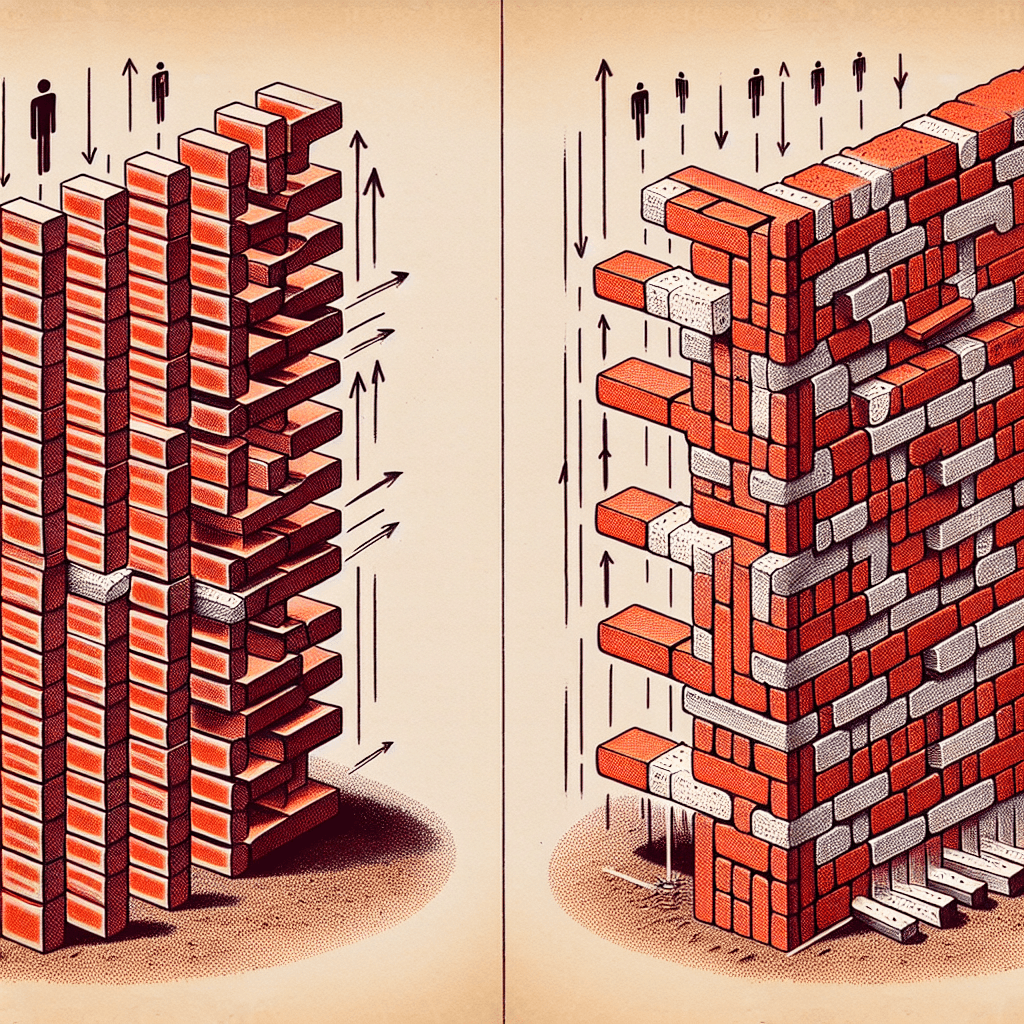Why are the bricks in a wall staggered instead of stacked in straight columns
That familiar staggered pattern on a brick wall isn't for looks; it’s the crucial engineering trick that prevents a stable structure from becoming a weak collection of pillars ready to topple.


Too Long; Didn't Read
TLDR: Staggering bricks distributes weight and locks them together, creating a much stronger and more stable wall. Stacking them in straight columns creates continuous weak vertical joints that can easily crack and cause the wall to collapse.
The Secret Strength of Walls: Why Are Bricks Staggered Instead of Stacked in Straight Columns?
Have you ever stopped to look closely at a brick wall? It’s a common sight, the backdrop to our cities and homes. But amidst the familiar red and brown hues lies a fundamental design principle that we often overlook. The bricks aren't stacked neatly one on top of the other like children's building blocks. Instead, they are deliberately offset in a staggered pattern. This isn’t an aesthetic choice; it’s a non-negotiable rule of engineering that separates a stable, long-lasting wall from a pile of rubble waiting to happen. This post will explore the crucial structural reasons behind staggering bricks and explain why this simple technique is the foundation of masonry's incredible strength.
The Fatal Flaw of Stacking: Continuous Vertical Joints
To understand why staggering is so important, we must first look at what would happen if we didn’t do it. Imagine a wall where bricks are stacked in perfect vertical columns. While it might look orderly, it would be incredibly weak.
The primary issue is the creation of continuous vertical joints. These are the seams filled with mortar that would run in an unbroken line from the top of the wall to the bottom. These joints act as pre-defined fault lines. Any force applied to the wall—whether it's the sideways pressure of strong wind, the shifting of the ground beneath it, or even someone leaning against it—will concentrate its stress along these weak vertical seams. Think of it like a perforated line on a piece of paper; it’s designed to tear easily. A stacked brick wall is essentially filled with these perforations, making it highly susceptible to cracking and collapsing under pressure.
The Staggered Solution: Introducing the "Bond"
The technique of staggering bricks is known in masonry as creating a bond. The most common pattern you see is called a "running bond" or "stretcher bond," where each brick is centered over the joint between the two bricks below it. This simple-yet-brilliant method completely changes the wall's structural dynamics.
By overlapping the bricks, the bond eliminates continuous vertical joints. Instead of creating weak columns, it weaves the individual bricks together into a single, cohesive structural unit. The load from any single brick is no longer transferred directly downwards but is distributed across the two bricks beneath it. This process continues down the entire wall, spreading forces both vertically and horizontally. An apt analogy is to compare touching your fingertips together versus interlacing your fingers. The interlaced grip is exponentially stronger because the force is shared and locked together, which is exactly what a proper brick bond does for a wall.
The Tangible Benefits of a Strong Bond
This principle of load distribution provides several critical advantages that ensure a wall is safe, stable, and durable for decades or even centuries.
- Superior Load Distribution: The primary benefit is distributing weight and stress over a wider area. This prevents pressure from concentrating in any one spot, drastically increasing the wall's overall strength and its ability to carry the load of floors and roofs above it.
- Enhanced Lateral Stability: Staggered walls are significantly better at resisting lateral (sideways) forces. The interlocking nature of the bricks helps the wall stand firm against wind, soil pressure, and even minor seismic events, which would easily topple a vertically stacked wall.
- Resistance to Cracking: Without continuous weak points, it's much harder for cracks to form and propagate through the wall. Temperature fluctuations and slight ground settlement might cause tiny, non-critical fissures, but the bonded pattern prevents them from becoming large, structure-threatening cracks.
While the running bond is the most common, other patterns like the English bond and Flemish bond also use this same core principle of staggering to achieve strength, often adding their own unique aesthetic flair and structural characteristics.
Conclusion
The next time you walk past a brick building, take a moment to appreciate the simple genius of its staggered pattern. This design isn't arbitrary; it is the very essence of what makes a brick wall strong. By avoiding the fatal weakness of continuous vertical joints, masons create a bonded, interlocking structure that effectively distributes loads and resists external forces. What appears to be a simple pattern is, in fact, a fundamental engineering solution that has allowed brick to remain one of the most reliable and enduring building materials in human history. It’s a testament to how a small design detail can make all the difference between something that stands for a season and something that stands for centuries.
More Articles

Why do many jet engines have a white spiral painted on their center cone?
That mesmerizing spiral on a jet engine isn't just a quirky design—it's a simple but brilliant visual trick that serves as a life-or-death warning to ground crews.

Why is the Statue of Liberty green instead of copper-colored?
She didn't always have that famous green glow; discover the 30-year chemical reaction that transformed Lady Liberty from a shiny copper statue into the iconic symbol we know today.

Why were cats once arranged in a box to be played as a musical instrument?
It sounds like a macabre myth, but for a brief, bizarre period in history, the world's cruelest instrument was designed to jolt a monarch from melancholy using a symphony of feline shrieks.